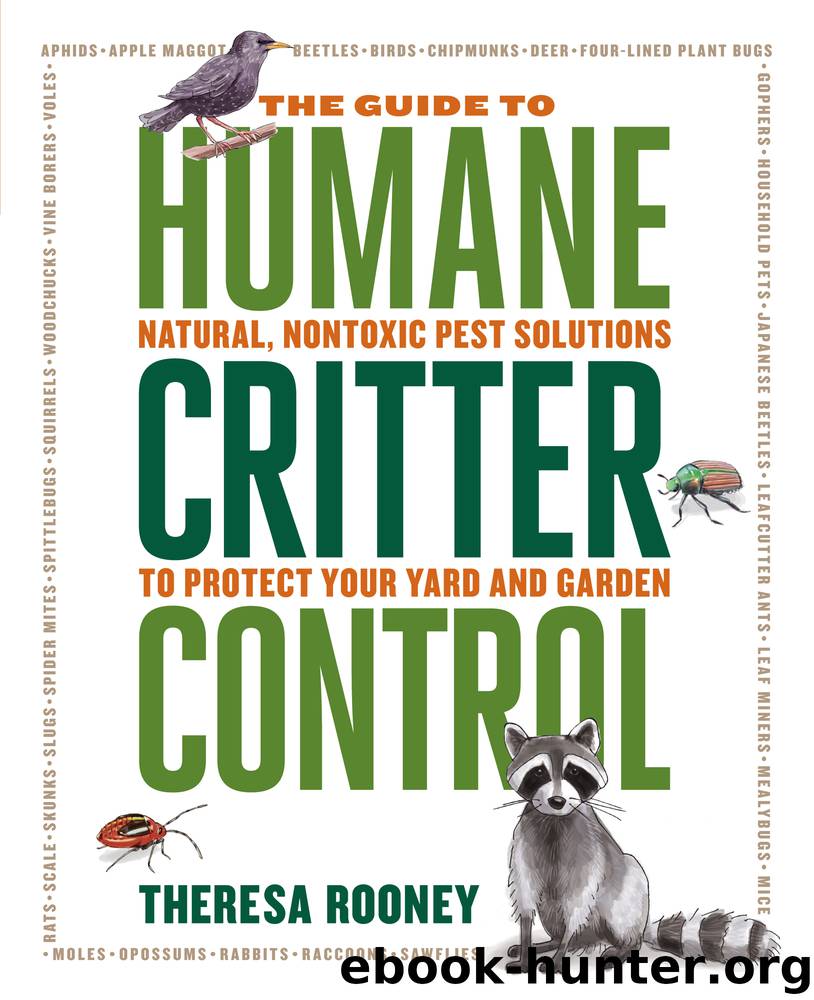The Guide to Humane Critter Control by Theresa Rooney

Author:Theresa Rooney
Language: eng
Format: epub
Publisher: Cool Springs Press
Published: 2017-12-29T05:00:00+00:00
Seemingly Scary or Bad Insects That Are Really Beneficial in Your Garden
ANTS: They eat lots of weed seeds, aerate the soil, and clean away some of the dead insects and birds. Ants may also milk aphids. If you see them on plants look for aphids. They are a clue for
the gardener.
BEETLES: Most beetles are beneficial. They eat lots of other insects and clean up dead insects and birds. They are also good at aerating the soil.
BEES: They may sting and buzz noisily and can seem scary, but most are shy and gentle and just want to do their business of gathering nectar and pollen for their colony or their young. If a honey bee stings you, she will die. The stinger usually gets stuck in your skin and, when the bee tries to pull away, it rips out of the abdomen—making stinging you a last resort. Most native bees and bumblebees can sting you many times, but they seldom sting at all unless you threaten them.
CATERPILLARS: Many of these insects turn into beautiful, gentle butterflies or moths. All are a favorite food for adult birds to feed to their young. Young birds need high-protein diets and caterpillars are the perfect food.
EARWIGS: They look scary but really are not. Earwigs eat decaying organic matter, breaking it down even further. Usually, they don’t bother plants unless their numbers are very high or other food sources are very low.
SLUGS: These sometimes can be a problem on hostas. Pull back the mulch and, if needed, use iron phosphate to kill them. Skunks and snakes eat a lot of slugs. Some birds will too. If you usually have a slug problem, before you expect them, lay down boards in the evening. In the morning, scrape the slugs hiding under them into the trash or out on the driveway for the birds to enjoy. They can increase in numbers exponentially, so be very proactive. Once your garden is diverse and healthy, you may want to leave mulch in place, as it will be the home of many beetles that can help keep slug populations in check. Invite birds in with bird baths or other water features.
TOMATO HORNWORMS: These are the larval stage of the sphinx or hawk moth and are devastating to your tomato crop. You can handpick the hornworms.
WASPS AND HORNETS: Often confused with bees, they are not “hairy” and they have a waist between their abdomen and thorax. Wasps and hornets are more territorial than bees and will protect their nest and young—and can sting more than once doing so. When frightened, they emit a pheromone that warns the entire colony of an impending attack. If you are stung, leave the area as quickly and quietly as possible. The female wasps are the ones that sting; the males do not. As long as you can leave their nests alone, they usually leave you alone too. If a nest is in a high-traffic area, you may need to remove it, but if it is far up in a tree or in another out-of-the-way place, you may be able to leave it alone.
Download
This site does not store any files on its server. We only index and link to content provided by other sites. Please contact the content providers to delete copyright contents if any and email us, we'll remove relevant links or contents immediately.
Periodization Training for Sports by Tudor Bompa(8171)
The Body: A Guide for Occupants by Bill Bryson(4976)
The MacArthur Bible Commentary by John MacArthur(4750)
The Sports Rules Book by Human Kinetics(4297)
What It Really Takes to Get Into Ivy League and Other Highly Selective Colleges by Hughes Chuck(3697)
Marijuana Grower's Handbook by Ed Rosenthal(3623)
The Sprouting Book by Ann Wigmore(3544)
The Martian by Andy Weir(3310)
Salt, Fat, Acid, Heat: Mastering the Elements of Good Cooking by Nosrat Samin(3108)
The Bread Bible by Rose Levy Beranbaum(3004)
Harry Potter 4 - Harry Potter and The Goblet of Fire by J.K.Rowling(2990)
Sapiens and Homo Deus by Yuval Noah Harari(2987)
The Marketing Plan Handbook: Develop Big-Picture Marketing Plans for Pennies on the Dollar by Robert W. Bly(2977)
Classic by Mary Berry(2943)
Martha Stewart's Baking Handbook by Martha Stewart(2797)
Screenplay: The Foundations of Screenwriting by Syd Field(2576)
The Plant Paradox by Dr. Steven R. Gundry M.D(2548)
50 Economics Classics by Tom Butler-Bowdon(2524)
The Cambridge Grammar Of The English Language by Rodney Huddleston Geoffrey K. Pullum(2385)
